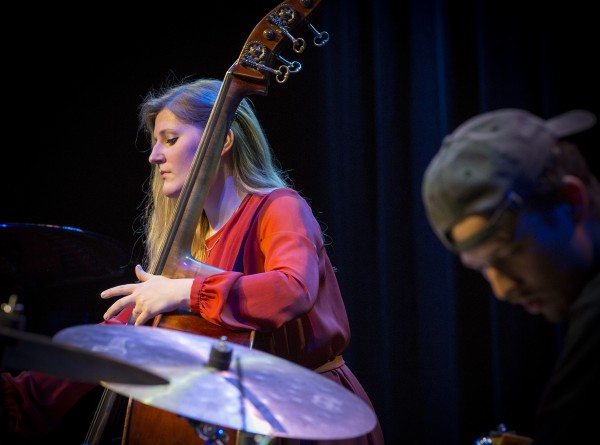Dec 9, 2025 12:28 PM
In Memoriam: Gordon Goodwin, 1954–2025
Gordon Goodwin, an award-winning saxophonist, pianist, bandleader, composer and arranger, died Dec. 8 in Los Angeles.…

The Lisa Wulff Quartett performs May 17 at the Opernhaus during JazzFest Bonn.
(Photo: Heike Fischer)The Rhine cuts a crooked line through Northwest Germany, arching westward gradually, making it easy to compare the river to the nation’s intensifying jazz scene: not straightahead, but not fully free.
The Lisa Wulff Quartett opened the 10th edition of Jazzfest Bonn on May 17 with its namesake leader delivering an unaccompanied bass solo, as the band’s malleable, funky drummer Silvan Strauss waved a pair of brushes in the air at the Opernhaus.
It’s rare that a drummer who’s not leading an ensemble so effortlessly becomes a focal point, but Strauss’ dexterous polyrhythm-pounding limbs were tough to ignore, even as Wulff’s compositions offered ample knotty turns and opportunities for the Hamburg-based troupe to move through straightahead and slightly skronky influences.
Classical vocalist Thomas Quasthoff, who fronted a swinging jazz trio, capped the evening, moving assuredly through transmuted renditions of Tina Turner and Stevie Wonder tunes, and offering a stark arrangement of “Summertime,” turning the Gershwin standard into something gothically dark.
His banter—well received by the audience—was in German, but he sang solely in English, hinting at the States’ ever-present sway over the music, even as the festival’s program sported a bevy of homegrown talent. Cleveland-born tenor saxophonist Joe Lovano, who performed May 18, was part of an American contingent—which included Jason Moran, Tower of Power, Yellowjackets and others at later shows—taking part in the festival, which wraps up May 31.
The next day at Domicil—a Dortmund bar and venue about 90 minutes northeast of Bonn—trombonist Janning Trumann was preparing to present four sets of jazz, improv and rock stuff from ensembles on his label, Tangible Music. (The gig was unaffiliated with the festival.) Trumann, who studied in New York for a few years, recognized the importance of musical and cultural exchange between German and U.S. performers, as well as the inherent difficulties in crossing those borders.
“I don’t know if New York needs Europe,” he wondered aloud before performing in a quartet called Trillmann. “I think they do ... . First of all, the scene is big enough out there. There are so many great musicians; maybe they think, ‘Why do we need European musicians?’ Of course, [European-based players] are good enough and play concerts there. It’s just hard for Europeans to play there—and have an impact on the American scene. I think there is an [influence on the U.S.], but I don’t know exactly what it is.”
For his May 19 set at the venue Pantheon, the final show of JazzFest Bonn’s first weekend, bassist Riccardo Del Fra led a quintet through music he described as “not a holiday postcard.” His point easily was made on a tune called “Children Walking (Through A Minefield).” The performance largely drew from the Paris-based bandleader’s 2018 album Moving People and his meticulous writing, not the combustible component parts of his ensemble, each member clearly displaying a keen grip on the material. A piano-bass rendition of “I’m A Fool To Want You”—a tune Del Fra said he frequently performed alongside Chet Baker during the 1980s—was a brief detour before the band returned to music from his latest batch of compositions.
Shake Stew—an Austrian troupe featuring two drummers behind full kits, two bassists working counterpoint, and a front line of trumpet, alto saxophone and tenor saxophone—capped the evening with more politically tinged fare, including a composition called “No More Silence.”
Earlier that day, just north in Cologne, saxophonist Angelika Niescier sat outside a cafe among a gaggle of lounging international journalists and festival programmers, fielding questions. She chatted about Winterjazz, an area festival she said is partially modeled on New York’s Winter Jazzfest, explaining that she was thrilled by her experience performing there several years ago.
“The awareness, it’s more woven into [New York],” said the bandleader—who has a new album, New York Trio, out on Intakt—while discussing the difficulties in increasing listeners’ familiarity with the music in Germany’s North Rhine-Westphalia region. “I still feel that it’s not the same case in Germany. You still have to put the word out and take care of this for every performance.”
She concluded optimistically: “It’s a gradual process.” DB

Goodwin was one of the most acclaimed, successful and influential jazz musicians of his generation.
Dec 9, 2025 12:28 PM
Gordon Goodwin, an award-winning saxophonist, pianist, bandleader, composer and arranger, died Dec. 8 in Los Angeles.…

Belá Fleck during an interview with Fredrika Whitfield on CNN.
Jan 13, 2026 2:09 PM
The fallout from the renaming of the John F. Kennedy Center for the Performing Arts to include President Donald…

Flea has returned to his first instrument — the trumpet — and assembled a dream band of jazz musicians to record a new album.
Dec 2, 2025 2:01 AM
After a nearly five-decade career as one of his generation’s defining rock bassists, Flea has returned to his first…

Dec 11, 2025 11:00 AM
DownBeat presents a complete list of the 4-, 4½- and 5-star albums from 2025 in one convenient package. It’s a great…

“It’s a pleasure and an honor to interpret the music of Oscar Peterson in his native city,” said Jim Doxas in regard to celebrating the Canadian legend. “He traveled the world, but never forgot Montreal.”
Nov 18, 2025 12:16 PM
In the pantheon of jazz luminaries, few shine as brightly, or swing as hard, as Oscar Peterson. A century ago, a…